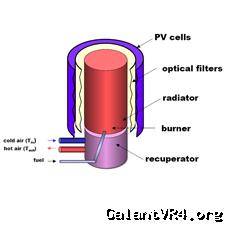kumfasa
Well-known member
"but I doubt I will be here long enough to share any outcome"
Ohh, come on, you were really growing on me, your not leaving so soon are you. Its good to shake the tree now and again.
If you stick around I promise to join in on the fun.
Why not get away from the alternator completely. You seem resourceful enough to make ones of these yourself.
"The technology, called thermophotovoltaics, uses gasoline to heat a light-emitting material, in this case tungsten. A photovoltaic cell then converts the light into electricity. The idea has been around since the 1960s, says John Kassakian, MIT electrical engineering and computer science professor. But until now, the light emitters for the photovoltaics produced inefficient and very costly systems. Improvements in the materials used in these latest devices – possible in part because researchers can modify the material structure at the nanoscale – are now making much more efficient systems, Kassakian says.
According to Kassakian, the system could potentially be a more efficient way to power electrical systems in a vehicle than the current alternator-based one, which wastes energy in two stages: the internal combustion engine converts only about 30 percent of the energy in fuel into movement, and then the alternator is only 50 percent efficient in converting the mechanical energy into electricity. He says a small prototype thermophotovoltaics device that could confirm the system’s improved efficiency might be ready in a year."

Ohh, come on, you were really growing on me, your not leaving so soon are you. Its good to shake the tree now and again.
If you stick around I promise to join in on the fun.
Why not get away from the alternator completely. You seem resourceful enough to make ones of these yourself.
"The technology, called thermophotovoltaics, uses gasoline to heat a light-emitting material, in this case tungsten. A photovoltaic cell then converts the light into electricity. The idea has been around since the 1960s, says John Kassakian, MIT electrical engineering and computer science professor. But until now, the light emitters for the photovoltaics produced inefficient and very costly systems. Improvements in the materials used in these latest devices – possible in part because researchers can modify the material structure at the nanoscale – are now making much more efficient systems, Kassakian says.
According to Kassakian, the system could potentially be a more efficient way to power electrical systems in a vehicle than the current alternator-based one, which wastes energy in two stages: the internal combustion engine converts only about 30 percent of the energy in fuel into movement, and then the alternator is only 50 percent efficient in converting the mechanical energy into electricity. He says a small prototype thermophotovoltaics device that could confirm the system’s improved efficiency might be ready in a year."











